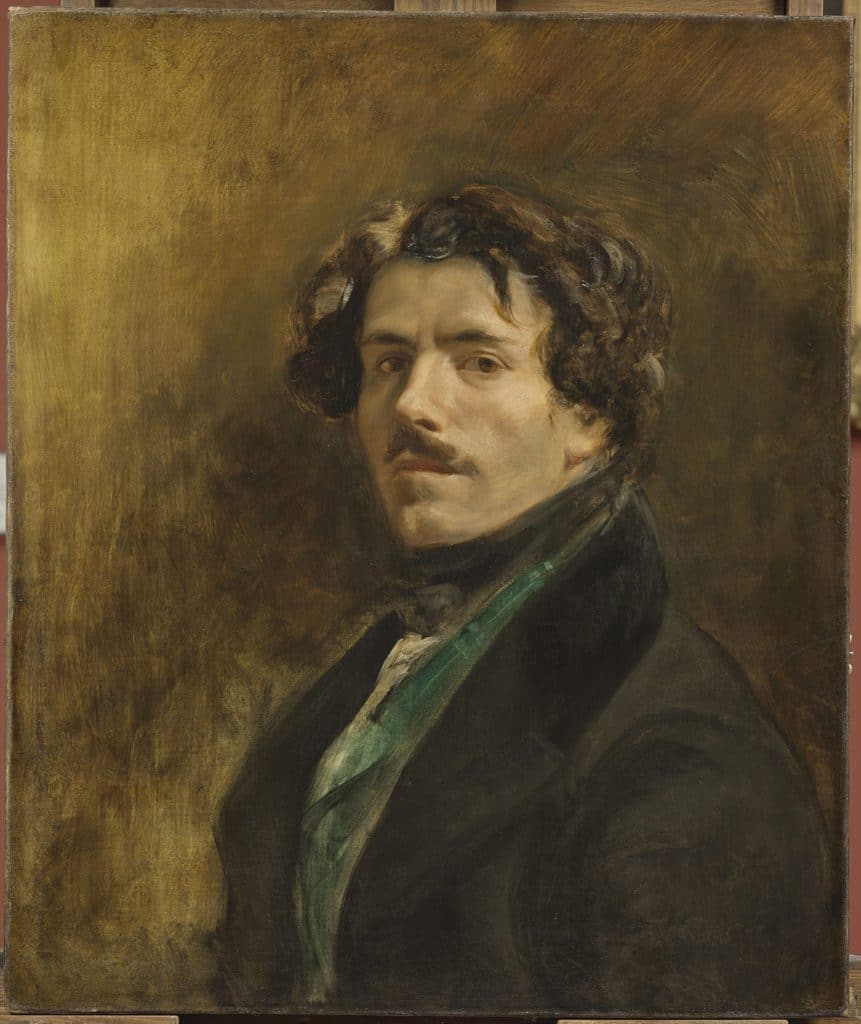Delacroix, a retrospective of one of the great French Romantic painters, is on view at the Metropolitan Museum of Art in Manhattan’s Upper East Side, from September 17, 2018 – January 6, 2019.
The Leader of French Romanticism
In life, Delacroix was considered the leader of the Romantic movement in 19th-century France.
Romanticism (1800 – 1850) abandoned Neoclassicism’s rigid glorification of the ancients, to tell a broader range of stories filled with emotion.
This was partly a response to the coldness of the Industrial Revolution. Life was changing from an agrarian life to an industrial life. People worried about the dullness of factory work, so they glorified the recent past with great drama.
Instead of pursuing rigid Renaissance ideals, Romantic artists filled their work with color and emotion. Delacroix’s mastery of color and emotion was so strong that his work foretold the modern age. It was the beginning of the blurring of life into a storm of feelings. Think Goethe. Delacroix was the seed of the Impressionists and Modern art.
“What moves those of genius, what inspires their work is not new ideas, but their obsession with the idea that what has already been said is still not enough.”
Delacroix
Delacroix
Ferdinand Victor Eugène Delacroix was born in Saint-Maurice, France on August 26, 1798 at the end of the French Revolution.
Delacroix was inspired by the emotions of Rubens and Venetian Renaissance painters. He was a master technician. Some consider Delacroix to be the last Old Master.
Delacroix’s chief rival was the Neoclassical painter Ingres. Delacroix’s work can be seen in contrast and competition with Ingres.
Like Picasso later on, Africa was an inspiration. In his day, artists went to Italy to study. Delacroix took an opportunity to visit Morocco and this expanded his world view. He saw Morocco as a living ancient past.
Delacroix was a master marketer. He actively sought fame in the Paris Salon, the Louvre’s annual exhibition of then-contemporary art. As a young artist, Delacroix achieved fame among the elite. In his old age, he foretold Impressionism.
Delacroix died in Paris, France in 1863.
Delacroix Exhibition
Delacroix at the Metropolitan Museum of Art is the artist’s first major retrospective in North America. It’s produced with the Musée du Louvre in Paris.
Delacroix is well known by name, though his work is less well known. The exhibition includes more than 150 paintings, drawings and manuscripts. Many are being shown in the United States for the first time. The exhibition includes many of the artist’s most famous works.
This exhibition provides deep perspective by showing both drawings and paintings so you can see the development of the artist’s ideas from drawing to painting and over time. This is a once in a lifetime exhibition.
Iconic paintings in the exhibition include:
- Greece on the Ruins of Missolonghi (1826)
- The Battle of Nancy (1831)
- Women of Algiers in Their Apartment (1834)
- Medea about to Kill Her Children (1838)
Delacroix made some paintings to be shown together. One such grouping is:
- Women of Algiers in Their Apartment (1833-1834)
- A Street in Meknes (1832)
- A Collision of Arab Horsemen (1834)
These paintings haven’t been seen together since they left Delacroix’s studio.
The only way to really connect with the enormity of Delacroix’s work is to see the work in life. Artists and art lovers will visit this exhibition several times, and each time come away with something new.
The exhibition is curated by Asher Miller, Associate Curator in the Department of Paintings at the Met with Sébastian Allard, the Louvre Director of Paintings and Côme Fabre Louvre curator.
The exhibition is in Gallery 899. It is accompanied by a catalog.
The first quality in a picture is to be a delight for the eyes. This does not mean that there does not need to be any meaning in it. But it’s like poetry which if it offends the ear, all the meaning in the world will not save it from being bad.
Delacroix’s final journal entry, June 22, 1863
Delacroix Tickets
Regular admission (including tickets purchased online) is $25 for adults, $17 for Seniors (65 and over), $12 for students, and free for children under 12 with an adult.
If you are a New Yorker and these prices are too much for you, don’t be dismayed. The Met has a policy of allowing New Yorkers (the entire state) to pay what you choose when you buy tickets at the ticket counter. You must show some kind of New York address identification.
Tickets include same day admission to The Met Fifth Avenue, The Met Breuer, and The Met Cloisters.
Get tickets at metmuseum.org
Met Fifth Avenue
1000 5th Avenue, New York, NY 10028
(at 82nd Street)
Upper East Side, Manhattan
(212) 535-7710
Hours
- Sunday – Thursday: 10 am – 5:30 pm
- Fridays & Saturdays: 10 am – 9 pm
Subway
- (4) (5) (6) to 86th St. Walk three blocks west to Fifth Avenue. It takes about 10 minutes.
- (1) to 86th St. Take the M86 bus across town to Fifth Avenue
- (C) to 81st St. Take the M79 bus across town to Fifth Avenue
Bus
- From Uptown: M1, M2, M3, M4 along Fifth Avenue
- From Downtown: M1, M2, M3, M4 along Madison Avenue
- Crosstown: M79 bus to Fifth Avenue

